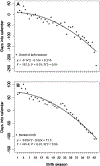Discovery of a secular trend in Cayo Santiago macaque reproduction
- PMID: 26540010
- PMCID: PMC10246351
- DOI: 10.1002/ajp.22502
Discovery of a secular trend in Cayo Santiago macaque reproduction
Abstract
Reproductive synchrony and the consequent clustering of births are hypothesized to be regulated by seasonal changes in rainfall and food availability. Such climate-related seasonality is, however, questionable in tropical populations occupying temporally invariant habitats year round. Using the long-term data of the Cayo Santiago rhesus macaques from 1973 to 2013, this study distinguishes synchrony (a greater than chance clustering of births) from seasonality (a cluster of births during a period of the year when abiotic conditions are favorable) and shows that females are highly synchronized (>72% of births in a 3-month period) but the effects of environmental zeitgebers on reproduction are overridden by biological factors. Specifically, biotic and abiotic factors including (i) loss of immature offspring; (ii) population density; (iii) age at delivery; (iv) rainfall; and (v) changes in colony management were modeled in relation to the annual onset of births and the median birth date. Females experiencing loss of immature offspring had an interbirth interval of <365 days in average and the proportion of these females increased up to 48% due to changes in colony management overtime, although reproductive synchrony increased with increasing population density. A secular trend in both the onset of births and the median date of birth is documented and the model predicts that the median birth date will advance across all calendar-based seasons by 2050. The secular trend in reproduction appears to be triggered by changes in the age at delivery of females, the absence of physiological constraints from maternal investment due to offspring loss, shorter interbirth interval, and a higher degree of coordination due to increasing population density. This study challenges the reproductive phenology previously described for rhesus macaques highlighting the importance of long-term studies in addressing the ultimate causes of reproductive synchrony.
Keywords: Macaca mulatta; interbirth interval; lactational anovulation; reproductive phenology; seasonal reproduction; synchronization.
© 2015 Wiley Periodicals, Inc.
Figures





Similar articles
-
Climate and seasonal reproduction in the Cayo Santiago macaques.Am J Primatol. 1985;9(2):87-99. doi: 10.1002/ajp.1350090203. Am J Primatol. 1985. PMID: 32102495
-
What cortisol can tell us about the costs of sociality and reproduction among free-ranging rhesus macaque females on Cayo Santiago.Am J Primatol. 2016 Jan;78(1):92-105. doi: 10.1002/ajp.22368. Epub 2015 Jan 16. Am J Primatol. 2016. PMID: 25643836 Free PMC article. Review.
-
Reproductive performance, population dynamics and anthropometrics of the free-ranging Cayo Santiago rhesus macaques.J Med Primatol. 1984;13(5):247-59. J Med Primatol. 1984. PMID: 6512846
-
Assessing Variance in Male Reproductive Skew Based on Long-Term Data in Free-Ranging Rhesus Macaques.Am J Primatol. 2025 Feb;87(2):e23687. doi: 10.1002/ajp.23687. Epub 2024 Oct 22. Am J Primatol. 2025. PMID: 39436033 Free PMC article.
-
A 75-year pictorial history of the Cayo Santiago rhesus monkey colony.Am J Primatol. 2016 Jan;78(1):6-43. doi: 10.1002/ajp.22381. Epub 2015 Mar 12. Am J Primatol. 2016. PMID: 25764995 Free PMC article. Review.
Cited by
-
Is male rhesus macaque facial coloration under intrasexual selection?Behav Ecol. 2017 Nov-Dec;28(6):1472-1481. doi: 10.1093/beheco/arx110. Epub 2017 Sep 11. Behav Ecol. 2017. PMID: 29622929 Free PMC article.
-
Coming to the Caribbean-acclimation of Rhesus macaques (Macaca mulatta) at Cayo Santiago.Am J Biol Anthropol. 2023 Jun;181(2):271-295. doi: 10.1002/ajpa.24748. Epub 2023 Apr 21. Am J Biol Anthropol. 2023. PMID: 37083128 Free PMC article.
-
Higher offspring mortality with short interbirth intervals in free-ranging rhesus macaques.Proc Natl Acad Sci U S A. 2019 Mar 26;116(13):6057-6062. doi: 10.1073/pnas.1817148116. Epub 2019 Mar 15. Proc Natl Acad Sci U S A. 2019. PMID: 30877247 Free PMC article.
-
Differential effects of early life adversity on male and female rhesus macaque lifespan.Ecol Evol. 2023 Nov 5;13(11):e10689. doi: 10.1002/ece3.10689. eCollection 2023 Nov. Ecol Evol. 2023. PMID: 37937273 Free PMC article.
-
Density-dependent feedback across nested levels of organization in a social primate.J Anim Ecol. 2025 May;94(5):971-984. doi: 10.1111/1365-2656.70028. Epub 2025 Mar 17. J Anim Ecol. 2025. PMID: 40091536
References
-
- Aureli F, De Waal FBM. 2000. Natural conflict resolution. Berkeley and Los Angeles, California: University of California Press. p 133.
-
- Bercovitch FB, Berard JD. 1993. Life history costs and consequences of rapid reproductive maturation in female rhesus macaques. Behavioral Ecology and Sociobiology 32:103–109.
-
- Bercovitch FB, Goy RW. 1990. The socioendocrinology of reproductive development and reproductive success in macaques. In: Ziegler TE Bercovitch FB, editors. Socioendocrinology of Primate Reproduction. New York: WileyLiss. p 59–93.
-
- Bercovitch FB, Lebron MR, Samuel Martinez H, Kessler MJ. 1998. Primigravidity, body weight, and costs of rearing first offspring in rhesus macaques. American Journal of Primatology 46:135–144. - PubMed
-
- Berman CM. 1989. Trapping activities and mother-infant relationships on Cayo Santiago: a cautionary tale. In Kessler MJ, editor. Proceedings of the Meeting to Celebrate the 50th Anniversary of the Cayo Santiago Rhesus Monkey Colony. Puerto Rico Health Sciences Journal 8:73–78. - PubMed
Publication types
MeSH terms
Grants and funding
LinkOut - more resources
Full Text Sources

